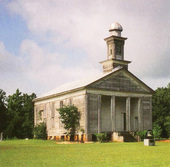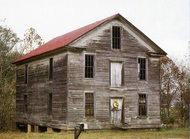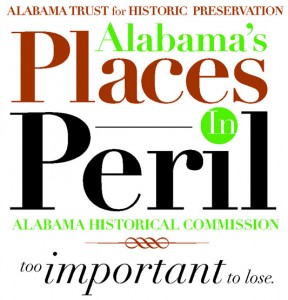 Click image to enlarge.
Click image to enlarge.
 Click image to enlarge. Click image to enlarge. There has been a lighthouse on Sand Island since 1830, the earliest being nothing more than an iron spindle with a lard-fueled lamp. A more permanent structure was constructed in 1837, only to be razed by Confederates concerned that the light might assist Union forces in their attempts to navigate Mobile Bay. The current lighthouse, along with a no-longer-extant Victorian cottage, was built in 1871. More than an aid to navigation, this lighthouse is a work of art. The lighthouse tower, which rises sixty feet above sea level, is constructed of Flemish bond masonry with massive granite lintels and sills at door and window openings. Atop the tower is an iron-lantern light and a crow's nest supported by cast-iron Victorian brackets.
0 Comments
 Click image to enlarge. Click image to enlarge. Once a vital part of the community, Pleasant Hill Presbyterian Church, like many other country churches of its vintage (c. 1855), has become an abandoned, deteriorating landmark in a rural landscape. Local residents keep the grass cut in the community cemetery to the rear of the sanctuary, but no one monitors the decline of the once prominent structure. The church is owned by the Pleasant Hill Cemetery Association.  Click image to enlarge. Click image to enlarge. The circa 1870 Braswell grist mill harkens to the days when freshly ground corn meal and flour were an integral part of everyday diets for people in rural Alabama. The frame two-story gabled structure retains a great deal of its original charm. With front Dutch doors and re turned cornices in the gables, the quaint building is surrounded by a bucolic landscape of rolling hills, meadows, and hardwoods. One of only a handful of comparable mills left in the state, the Braswell Mill is abandoned and in desperate need of attention to prevent its demise. An imaginative renovator might turn this property in to an antique shop, a country store, an office, a vacation home, or a museum. This year the National Trust for Historic Preservation, the national nor-for-profit preservation advocacy group, listed historically black colleges nationwide on their most endangered historic places list. Says the Trust: "Having shaped the lives of generations of African Americans, these proud institutions need funding for rehabilitation and ongoing maintenance of many deteriorated campus landmarks." In an effort to bring awareness of the importance of these institutions to Alabama, AHC and APA have placed Alabama's black colleges and universities on our endangered list as well. Alabama has fourteen historically black colleges, including Alabama State University (Montgomery), Alabama A&M (Huntsville), Tuskegee University, and Talladega College. Budget constraints and the need for continued growth at these institutions often put historic resources in harm's way. Planning and development for these historic structures are key issues that need to be addressed by campus leaders.
 Click image to enlarge. Click image to enlarge. Quinlan Castle, located in Birmingham's Five Points South neighborhood, was constructed in 1927 to meet the demand for middle-income housing in a city that was experiencing unprecedented growth. The name of the seventy-two-unit apartment complex was later changed to the Royal Arms Apartments, but most people still refer to it simply as " the castle." With its turrets, stone construction, battlemented parapets, and open courtyard, Quinlan Castle is a fine and whimsical example of Romantic Revival architecture, a movement that glorified exotic and historical architectural styles. Other well-known examples of Romantic Revival include the Florentine Building, also in Birmingham, and the famous Fox Theatre in Atlanta. |
Alabama's Endangered Historic LandmarksEach year since 1994, Alabama Heritage has highlighted threatened historic sites throughout Alabama. The “Places in Peril” list has identified more than 215 imperiled historic resources throughout the state, and is compiled by the Alabama Historical Commission and the Alabama Trust for Historic Preservation. The locations highlight the results of deferred maintenance, perceived obsolescence, development pressures, and lack of funding—forces that now more than ever threaten our cultural legacy. But awareness is a powerful force, too, and can cultivate a renewed determination to be responsible stewards of our heritage. For more information, visit the AHC or the ATHP websites. Alabama Heritage is proud to bring to you a selection of the places designated as perilous. Please keep your comments to information relevant to the featured place in peril. Alabama Heritage reserves the right to delete any comment that we deem inappropriate. Archives
May 2024
|

 RSS Feed
RSS Feed